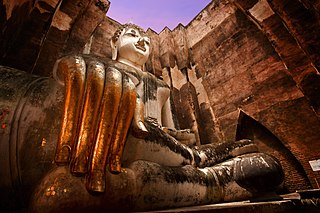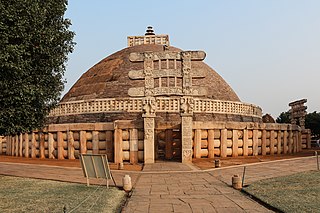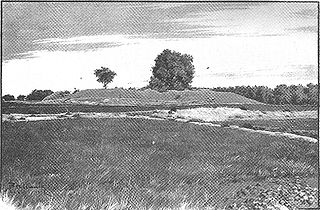
Sukhothai Historical Park covers the ruins of Sukhothai, literally 'dawn of happiness', capital of the Sukhothai Kingdom in the 13th and 14th centuries, in north central Thailand. It is near the city of Sukhothai, capital of Sukhothai Province.

In Buddhism, a stupa is a mound-like or hemispherical structure containing relics that is used as a place of meditation.

Sirkap is the name of an archaeological site on the bank opposite to the city of Taxila, Punjab, Pakistan.

Swat District, also known as the Swat Valley, is a district in the Malakand Division of Khyber Pakhtunkhwa, Pakistan. With a population of 2,309,570 per the 2017 national census, Swat is the 15th-largest district of Khyber Pakhtunkhwa with many popular tourist attractions.
Chakdara (چکدرہ) is a city in the Lower Dir District of Khyber Pakhtunkhwa, Pakistan. It's the second largest city in Dir Lower after Timergara. It serves as a gateway of Malakand Division. It's located in the center of Malakand Division at the entrance of the Lower Dir District, also near the entrance of the Swat District. The Swat Expressway also touches this area Chakdara interchange. Chakdara is about 130 km far from Peshawar, 40km from Mingora and 38 km from Timergara.
The Lower Swat Valley in Swat and Lower Dir Districts in Pakistan is an area of important archeological sites.

Saidū Sharīf is the capital of the Swat district, Khyber Pakhtunkhwa, Pakistan. The city also serves as the capital of the Malakand Division. It was named after Saidu Baba, a prominent leader of the former state of Swat.

The Swat River is a perennial river in the northern region of the Khyber-Pakhtunkhwa Province of Pakistan. The river's source is in the high glacial valleys of the Hindu Kush mountains, where it then flows into the Kalam Valley before forming the spine of the wider Swat Valley.

Malam Jabba is a hill station and ski resort in the Hindu Kush mountain ranges. It is nearly 40 km far from Saidu Sharif in the Swat Valley of the Khyber Pakhtunkhwa province of Pakistan. It is 314 km far from Islamabad and 51 km from Saidu Sharif Airport.

Mingora is a city in the Swat District of Khyber Pakhtunkhwa, Pakistan. Located on the Swat River, it is the 3rd largest city in Khyber Pakhtunkhwa and the 26th largest in Pakistan. Mingora is the largest city and the epicenter of social, cultural, and economic activities in Malakand Division, and also the largest in the northern part of Khyber Pakhtunkhwa.

Barikot is a town located in the middle course of the Swat River in Khyber Pakhtunkhwa, Pakistan. It is located about 20 km (12 mi) away from Mingora and the Butkara Stupa. It is the entrance town to the central Swat Valley with a population of approximately 25,000 people. Barikot is the location of an ancient citadel captured by Alexander the Great, with Chalcolithic remains dating back to c. 1700 BCE, and an early-historic period town dating back to c. 500 BCE. The Italian Archaeological Mission founded by Giuseppe Tucci has been excavating ruins of the ancient town of Bazira under Barikot since 1984.

Buddhism in Pakistan took root in the third century BCE under the Mauryan king Ashoka. The Major Rock Edicts of Ashoka inscribed on rock boulders in Mansehra and Shahbaz Garhi written in the Kharosthi script recording aspects of the emperor's dharma or righteous law represent some of the earliest evidence of deciphered writing in South Asia, dating to middle of the third century BCE. The Indo-Greek king Menander embraced Buddhism as attested in the Milinda Panha, which dates from sometime between 100 BC and 200 AD, following a dialogue with the monk Nāgasena in Sagala, present-day Sialkot.

Ghalegay is a village of Swat Valley, located at a distance of 14 km south of Mingora, on the left bank of Swat River. It is one of the main villages lying between the two cities, Mingora and Barikot.

Saidgai Lake also known as Saidgai Dand is a lake in the upper reaches of the Ushirai Dara within the Upper Dir District of the Khyber Pakhtunkhwa province of Pakistan. It is located at an elevation of 11,500 feet (3,500 m) above the sea level. It is located to the northwest of Gabin Jabba. The temperature is normally about 5 °C to 10 °C during hot months. Primarily, this lake attracts tourists from Dir as well as other regions of the country, especially during the months of June, July, and August. However, for the rest of the months, the lake remains covered by snow. Saidgai lake is at the boundary of Dir Upper and Swat.
Sherin Zada is a Pakistani journalist working for Hum News. He was previously associated with the Express News based in Swat Valley, and had also worked with The Express Tribune, an English Newspaper. He is known for his work during Taliban period over control of Swat Valley Pakistan. As a professional journalist, he covered or wrote highest number of reports and stories in the Valley. He is president of Swat Press club (2023).

Shaji-ki-Dheri is the site of an ancient Kanishka stupa about 6 kilometers from Peshawar, Pakistan.

Kunala Stupa is a Kushan-era Buddhist stupa and monastery complex to the south-east of Taxila, on a hill about 200 meters just south of Sirkap, Punjab, Pakistan, thought to date to the 2nd century CE. It is located on a hill overlooking the ancient Indo-Greek city of Sirkap.

The Saidu Sharif Stupa, excavated under the name Saidu Sharif I, is a Buddhist stupa located near the city of Saidu Sharif, at the foot of the mountains that separate the river valley Saidu from that of the river Jambil, in the Swat District of Khyber Pakhtunkhwa, Pakistan. The sacred area consists of two terraces built on the slope of the hill, through a cut in the rock on the north side. Artificial terracing includes one stūpa, surrounded by smaller monuments, and a monastery.

Nemogram stupa is located 45 km west of Saidu Sharif and 22 km from Birkot, on the right bank of Swat river in Pakistan.This site was discovered in 1966 and excavated in 1967–68. Swat is rich in historical landmarks as well as natural beauty. In every direction, these are tangled in the wide valley. Aurel Stein, a British archaeologist, and Tucci, who was followed by other Italians, worked tirelessly to document and preserve these monuments.
Gumbat Stupa is a 2nd-century Buddhist stupa located in Swat valley in Pakistan. It is situated about 9 kilometres south of Birkot in the Kandag Valley of Gandhara.



















